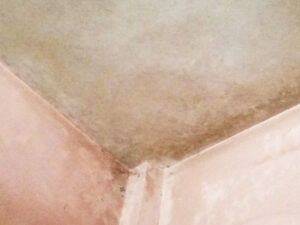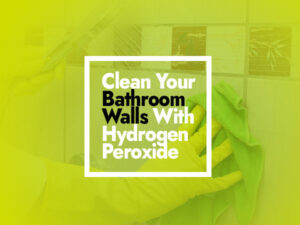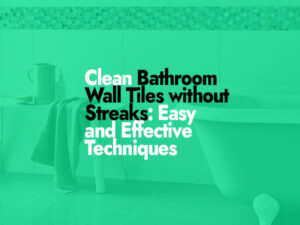If your basement serves as a place for storage, laundry, or living purposes, it can quickly become dirty and disorganized. Concrete basement floors and walls tend to collect dust, dirt and spots over time so regular cleaning should be undertaken to restore their beauty and functionality.
Cleaning your concrete basement might seem challenging, but it doesn’t need to be. With the appropriate tools and techniques, along with some hard work on your part. Your basement can become an inviting, refreshing space you’ll love spending time in.
I will show you everything you need to know to effectively and safely clean a concrete basement floor and walls, from green cleaning practices to deep cleansing methods. So whether it is time to remodel your space or you just want it clean for everyday living purposes. Read on and discover how you can tackle cleaning it like an expert!
How to Clean Concrete Floors and Walls of Your Basement: Step-by-Step Instructions for Success
Concrete basement floors and walls are durable yet low-maintenance surfaces. But over time can become dirty due to foot traffic, spills, or moisture exposure. Cleaning your concrete basement regularly is vital in order to stay safe, healthy, and presentable – in this section, we’ll show how.

Your equipment includes:
- Broom or vacuum
- Mop or scrub brush
- Bucket
- Warm water
- Cleaning solution (such as a commercial concrete cleaner or a homemade solution made from vinegar and water)
- Safety glasses and gloves
- Protective clothing
Step 1: Make Space
Before cleaning the floor and walls of your concrete basement, move any items such as furniture out of their way in order to make cleaning simpler. As well as prevent anything from breaking while doing it! Doing this also increases safety.
Step 2: Vacuum or Sweep
Using either a broom or vacuum, use it to sweep or vacuum all areas of the floor and walls that contain loose dirt, dust, or other contaminants from their respective locations. Including corners or hard to reach spots like under beds and behind furniture. Do this regularly so dust doesn’t spread while cleaning is being conducted. This step should help avoid dust becoming airborne when working through these tasks.
Step 3: Utilize your cleaning product
Now is the time to use your cleaning solution on both floors and walls, be they floor or walls. There are various approaches you can take when it comes to concrete cleaning. Either purchase commercial cleaners from stores or make your own solution using vinegar and water.
When using store-bought cleaners, follow their directions exactly regarding water addition and application. Alternatively, creating your own solution requires equal parts vinegar and warm water mixed together, add dish soap if you like for maximum effectiveness at cleaning!
Use a mop or scrub brush to spread the cleaning solution onto floors and walls, working small areas at a time so the solution does not dry up before being scrubbed away.
Step 4: Clean walls and floors thoroughly
Once the cleaning solution has been applied to both walls and floors, use either a mop or scrub brush to thoroughly cleanse them. This will get rid of any dirt, stains, or dust that has built up over time, while using stiff-bristled brushes can get rid of marks or spots which prove more challenging than usual to clean.
Step 5: Clean walls and flooring thoroughly
Once your floor and walls have been scrubbed clean, it’s time to rinse away your cleaning solution. Fill a bucket with clean warm water, use a mop or sponge, and change out often so you aren’t just spreading around dirty water.
Step 6: Allow walls and floor surfaces to dry naturally before proceeding further
Now is the time to dry the floors and walls using clean towels or a mop to absorb any extra liquid on the floor, while using a squeegee or clean towel on any extra water on the walls. Make sure any doors or windows remain open, to provide adequate airflow and ventilation during this process of drying out your home faster.
How to Keep Your Concrete Basement Clean
Once you understand how to clean the floor and walls of your concrete basement. the next step should be taking steps to maintain their cleanliness. Here are a few strategies for keeping it looking its best:
Sweep or vacuum the floor and walls regularly in order to clear away dirt and dust, mopping regularly will help avoid the build-up of dirt, as will placing doormats at entranceways in order to stop dirt from entering from outside sources. Soak up any spills as quickly as possible to stop them from becoming permanent stains, while installing a dehumidifier will help control wetness levels and stop mold or mildew growth.
Seal your concrete floor and walls to help seal out dirt and moisture, using only pH-neutral cleaners that won’t harm its surface. Avoid metal brushes or steel wool which may damage it further when cleaning concrete, instead opting for gentle solutions like soap. Before using cleaning solutions, always wear protective clothes and safety glasses in order to minimize exposure to possible irritants that might arise from using such solutions.
Cleaning your concrete basement floor and walls might seem like an impossible task, but with the proper tools and knowledge, it can become straightforward and effective. Routine care for the space ensures it remains healthy yet attractive. By following these steps and tips you’ll soon have a pristine space that you’re proud to show off!
Can I clean my concrete basement using a power washer?
Pressure washers are powerful tools that can be used to quickly clean a wide variety of surfaces, including concrete. But for cleaning basement floors specifically, using one may not be optimal.
Pressure washers can be effective tools for clearing away grime from concrete surfaces. However, misuse could damage it further. Too much force from the water may cause cracks or holes to form within it. Leak into crevices where mold could develop further compromising its surface, and potentially leading to even further destruction or growth.
Additionally, using a power washer indoors can be extremely hazardous. Its force of the water may cause it to splash back and potentially lead to slips and falls for users. Furthermore, its noise and vibrations could potentially irritate ears that might otherwise remain intact.
In order to effectively clean a concrete basement floor, avoid power washers in favor of mopping with a bucket or wet/dry vacuum, pH-neutral cleaner with a stiff-bristled brush (for tough spots), or soft bristled brushes and special cleaner designed to eliminate mold and mildew on walls (soft-bristled brush and special mold and mildew cleaner may be more appropriate).
Though pressure washers might appear like the easiest and safest way of cleaning concrete basement floors and walls. It should be avoided as this could damage and pose risks to both yourself and the concrete surfaces that you need to keep clean. A mop, cleaners, and products tailored specifically for cleaning will work just as effectively without placing anyone or their concrete surfaces at risk.
How should I approach mold growth on my concrete basement walls?
Mold growth on your concrete basement walls is dangerous not only to its appearance but also to your health. If there’s mold present on these surfaces, action must be taken quickly in order to eliminate it, and safeguard both yourself and the wall’s structural integrity.
As your first step toward eliminating mold growth, identify what factors contribute to its presence. This may include high humidity levels, inadequate airflow, or water entering through various leakages or cracks in walls and floors. Once this problem has been rectified, removal efforts can begin immediately.
To remove mold on concrete basement walls, it’s essential that you wear protective gear such as gloves, goggles, and a face mask in order to safeguard yourself against breathing in mold spores. A brush with stiff bristles should also be utilized along with a cleaner designed specifically to rid yourself of mildew and mold growth. You may require multiple scrubs of this area in order to eradicate all instances.
After cleaning walls, it’s crucial that they’re dried thoroughly to avoid future mold growth. Use fans or dryers to circulate air through and dry out the room more thoroughly. If mold developed as a result of water entering through any damaged ingress points or leakage points in walls or flooring. Any necessary water damage repairs must be addressed as well as adequate drainage to avoid future outbreaks of this problem.
Also, taking steps to prevent future mold growth is wise. This could involve making sure there is sufficient airflow, keeping humidity below 50%, and quickly fixing any water leaks or wetness issues that arise.
If mold appears on the walls of your basement, act quickly to eliminate and treat its cause. Use appropriate cleaning products and safety gear when dealing with this situation. Take measures to stop further mold growth by taking preventative steps if the problem worsens. In severe cases call a professional for advice or services.
How can I clean my concrete basement using bleach?
Bleach can be an effective cleaner that kills mold and mildew, but it may not always be the ideal way to maintain clean floors and walls in a concrete basement.
Bleach can kill mold and mildew while clearing away stains from pavement surfaces. Yet its harsh cleaning abilities may prove damaging to the pavement itself. Bleach’s powerful solvent nature means it may break down concrete surface layers to render them brittle or alter the color. As well as change its porous nature causing potential water and mold growth issues in the future.
If you decide to clean your concrete basement with bleach, be mindful so as to not damage its surface. Before beginning any application of bleach solution on a large area of surface area. Conduct an initial test in an inconspicuous spot first to make sure there will be no changes or harm done to its color or appearance. Wear safety equipment like gloves and goggles in case any bleach gets on the skin.
Mix appropriate proportions of bleach to water as too much bleach could harm its appearance. Be cautious not to oversaturate too strong of bleach can damage its effects when cleaning concrete basement surfaces, as too strong an application. It could easily damage its aesthetic qualities. Be cautiously apply the solution if cleaning with too much strength of bleach, as too strong a concentration can damage its appearance causing surface damage!
Once using bleach for cleaning purposes, it’s also vital that the area be given an effective rinse to eliminate any remnants and ensure no harmful or hazardous buildup remains on surfaces. As any excess can increase the damage caused to surfaces as well as increase the chances of someone slipping and falling.
Even though bleach can effectively eliminate mold and mildew from basement floors and walls, as well as remove spots, care must be taken when using it to do this. Test on a small area first, dilute as necessary, wear safety gear when possible, and rinse well afterwards. Or switch out bleach for a cleaner made specifically for concrete surfaces, that are pH neutral instead in order to minimize potential damages that it might cause.
How can I prevent mold growth on the concrete walls in my basement?
Mold growth on concrete basement walls must be prevented in order to live safely and healthily. Here are a few strategies you can employ in order to put an end to its spread:
Keep humidity levels low: Maintain low humidity levels to eliminate mold growth. A dehumidifier is ideal for keeping humidity below 50%, that way you’ll prevent mold growth!
Improve airflow: Without adequate ventilation, trapped moisture in the air makes mold growth easy. For areas with high levels of humidity, installing fans, opening windows, or running exhaust fans ensures adequate airflow. It may help alleviate mold growth required for maximum productivity.
Fix all water leaks: Water entering a basement is one of the primary factors contributing to mold growth. Regularly inspect it for signs of water leakage or damage and address any identified immediately. For instance by fixing pipe leakage, filling cracks in floors, and installing sump pumps to stop pooled-water accumulations in your space.
Use mold-resistant products: Select items that do not grow mold. Consider coating or painting your basement walls with antifungal ingredients in these items that inhibit mold from growing.
Clean regularly: Always clean the walls in your basement regularly. Dirt, dust, and moisture buildup on basement walls can lead to mold growth. Use a pH-neutral cleaner designed specifically for concrete surfaces to remove all mold spores on them as soon as you notice.
Overall, to prevent mold growth on the concrete walls of your basement. It’s best to maintain low humidity levels, improve ventilation, fix water leaks, and use mold-resistant products, as well as regularly clean walls. It creates an ideal living environment and discourages mildew and mold growth. Take these steps in order to create an inviting and healthy atmosphere in which to live while keeping mold at bay!
Final Thought
Clean the floors and walls of a concrete basement regularly to keep it safe and healthy for its inhabitants. There are various effective means of doing this, from getting rid of dirt or spots to eliminating mold or mildew growth. Cleaners/degreasers with pH values under 7, power cleaning, or using stiff-bristled brushes are effective tools for cleaning surfaces properly.
By following the techniques in this piece you can effectively cleanse both concrete walls and floors in your basement. So as to prevent future issues with health or structural concerns that arise later on. Make sure safety steps such as wearing protective clothing while using effective products so you can thoroughly complete this job successfully!







